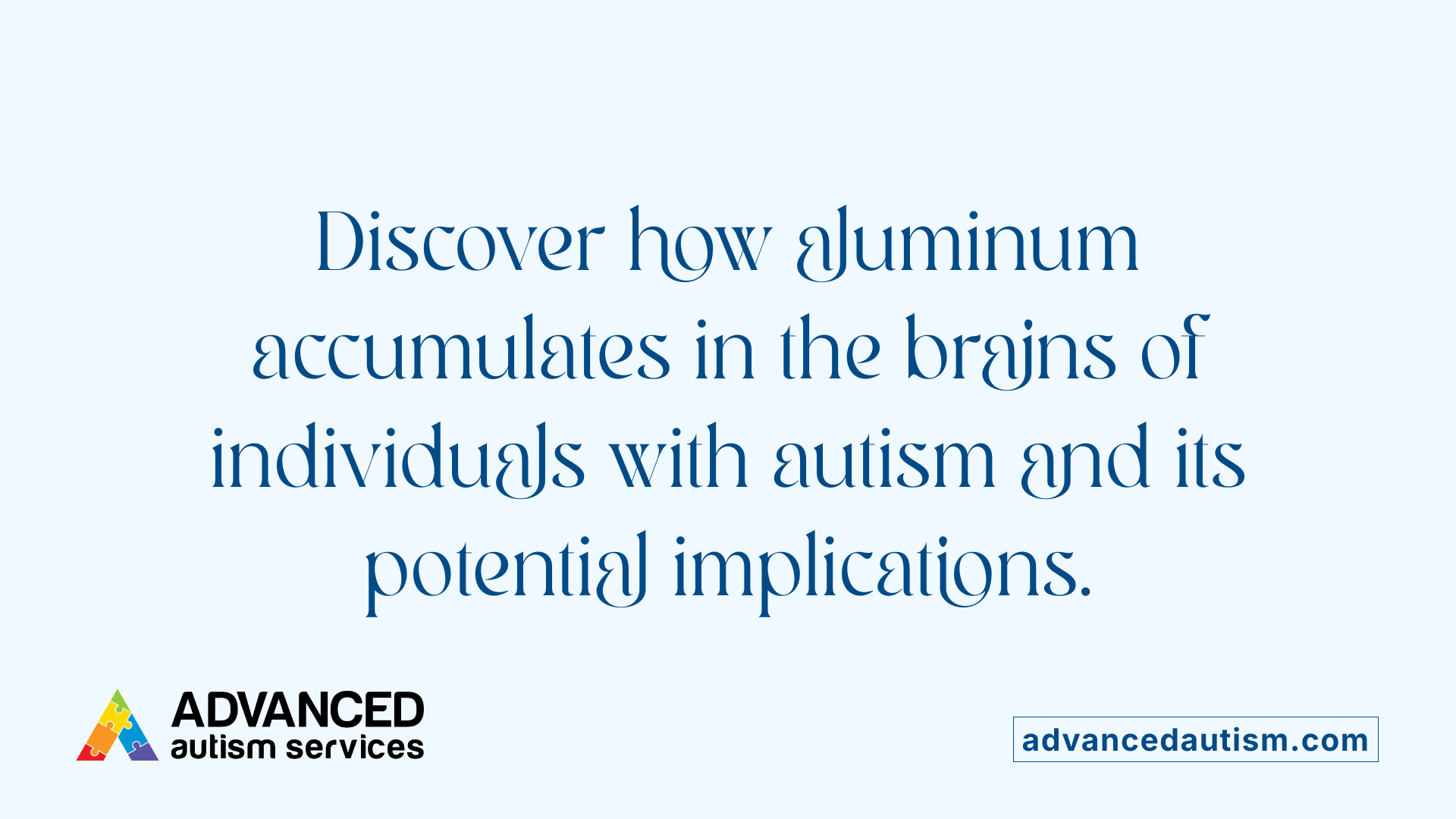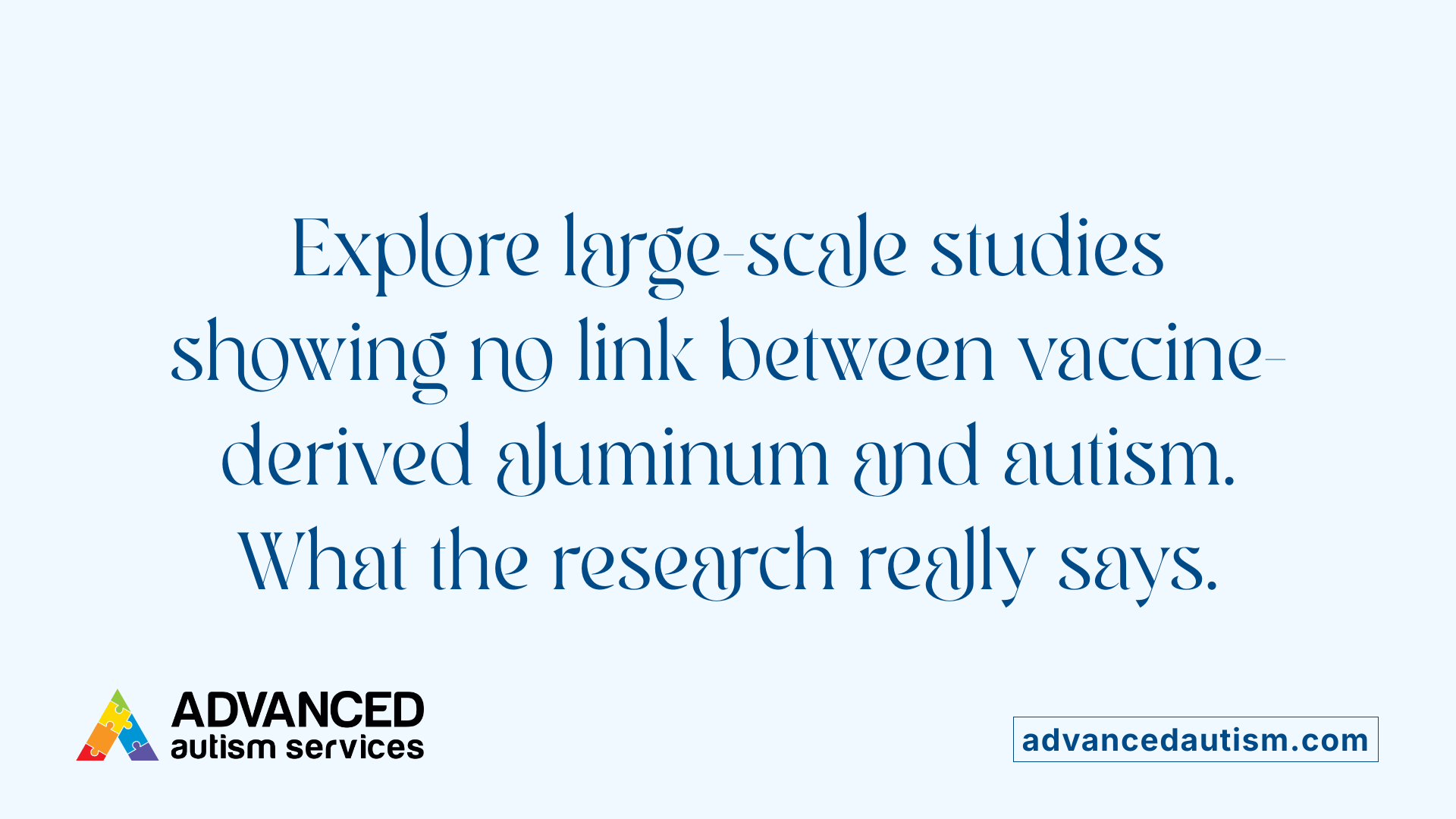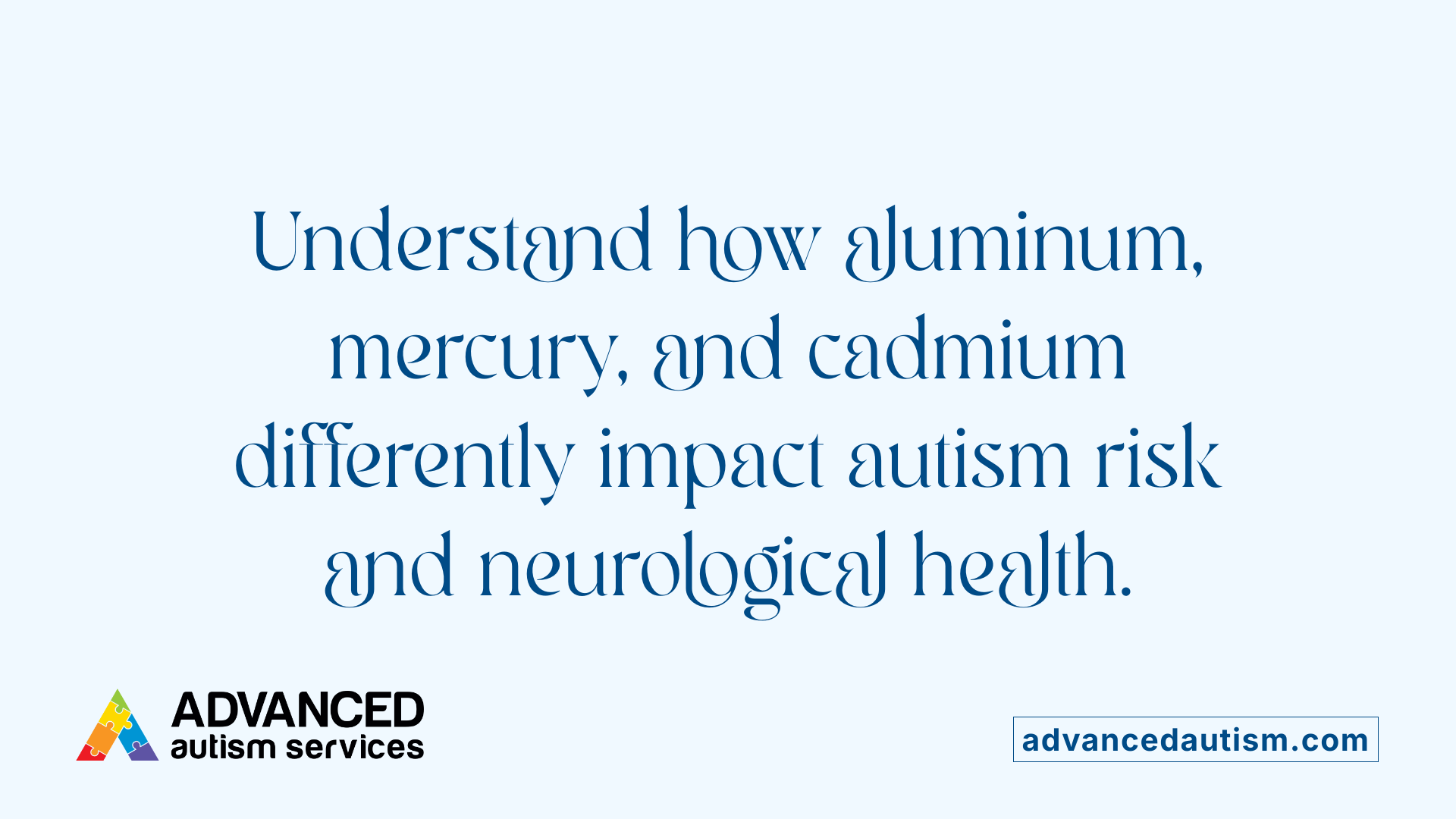Introduction to the Aluminum-Autism Debate
The possibility of a connection between aluminum exposure and autism spectrum disorder (ASD) has sparked much public concern and scientific investigation. While some studies highlight high aluminum levels in the brain tissues of individuals with ASD, extensive epidemiological research in children challenges the notion that aluminum, particularly from vaccines, causes autism or neurodevelopmental harm. This article delves into the latest scientific findings and the role of behavioral therapies in supporting individuals with autism, aiming to clarify the evidence behind the aluminum-autism hypothesis.
Aluminum Presence in the Brains of Individuals with Autism: What Does the Science Say?

Does aluminum accumulate in the brains of individuals with autism?
Research using sensitive techniques like transversely heated graphite furnace atomic absorption spectrometry has revealed that aluminum accumulates at consistently high levels in brain tissue from individuals with autism spectrum disorder (ASD). Some of these levels are among the highest recorded in human brain studies. This accumulation is not uniform across the brain; notably, the occipital lobe exhibits particularly elevated aluminum concentrations compared to other regions.
How is aluminum found within brain tissue relevant to understanding autism?
Aluminum in the brains of those with ASD is found inside various cell types beyond just neurons. It is present intracellularly within microglia-like cells and other inflammatory cells found in meninges, vasculature, as well as gray and white matter. This intracellular presence in non-neuronal cells suggests a possible pathway for how aluminum accumulates and could influence brain function in autism. The association of aluminum with these immune and inflammatory cells may provide clues about its role in the neuroinflammatory processes observed in ASD.
Distribution of aluminum across brain regions
The uneven distribution of aluminum highlights the occipital lobe as a hotspot for accumulation. This region's higher aluminum content could have implications for visual processing and other functions typically managed by the occipital cortex. Understanding these regional differences is essential for unraveling the potential impacts of aluminum on brain development and function in autism.
Potential mechanisms of aluminum accumulation in autism
The finding of aluminum within microglia-like and inflammatory cells points to neuroimmune involvement in aluminum deposition. Since microglia are the brain's resident immune cells, their role in engulfing and potentially transporting aluminum suggests possible mechanisms for aluminum retention and its impact on neural health. This intracellular aluminum could contribute to or exacerbate neuroinflammatory responses that are often linked to autism's pathology.
| Aspect | Details | Implications |
|---|---|---|
| Brain Aluminum Levels | High across ASD brains, especially in occipital lobe | May affect brain functions specific to this region |
| Cell Types with Aluminum | Neurons, microglia-like cells, other inflammatory cells | Indicates involvement of immune cells in aluminum processing |
| Aluminum Measurement Technique | Transversely heated graphite furnace atomic absorption spectrometry | Provides precise quantification of brain aluminum |
| Accumulation Mechanisms | Intracellular presence in immune-related cells suggests immune-mediated aluminum handling | Potential link to neuroinflammation in autism |
Epidemiological Evidence: Aluminum Exposure from Vaccines and Autism Risk

Large-scale observational studies
A comprehensive Danish study tracked 1.2 million children over a 24-year period, assessing 50 different health outcomes related to aluminum exposure from vaccines. This extensive observational research design provided a powerful dataset for investigating possible links between vaccine-derived aluminum and autism spectrum disorder (ASD).
Vaccine aluminum exposure and autism risk
The findings from this large cohort showed no statistically significant association between aluminum content in vaccines and the risk of developing ASD or other neurodevelopmental harm. Specific conditions such as Asperger’s syndrome and asthma also exhibited no increased risk related to aluminum exposure, based on hazard ratios near 1, indicating no effect.
Study design robustness and findings
This natural experiment design leveraged changes in vaccination policies over time, comparing varying aluminum doses among vaccinated children. Such methodology effectively minimizes confounding factors often encountered in studies using unvaccinated control groups. Additionally, standard epidemiological practices, such as excluding children with early mortality or pre-existing illnesses, further reduced potential bias.
Governmental and WHO safety reviews
Both the Danish government and the World Health Organization have thoroughly reviewed vaccine safety records concerning aluminum exposure. These health authorities concluded that vaccine-derived aluminum does not pose health risks, supporting the findings from the Danish study that vaccination-related aluminum is not linked to autism or neurodevelopmental disorders.
Environmental Heavy Metals and Autism: Differentiating Aluminum from Other Metals

How does aluminum’s association with autism compare to other metals like cadmium and mercury?
Meta-analyses of 18 studies on aluminum show mixed findings. When aluminum levels are measured in hair and urine samples, a positive association with autism spectrum disorder (ASD) is observed, suggesting higher aluminum may relate to ASD presence. However, the association reverses in blood samples, where a negative correlation is reported. This inconsistency highlights the complexity of aluminum's link to ASD.
In contrast, cadmium shows a generally negative association with ASD in hair and urine analyses, suggesting less likelihood of a direct causal role. Mercury stands out with a strong positive association with ASD across multiple biological samples—hair, urine, and blood. This consistent pattern supports concerns about mercury’s neurotoxic effects contributing to autism risk.
Why is it important to study different metals in relation to autism?
Understanding how various metals correspond to autism risk is crucial because these metals interact with the nervous system differently. Aluminum, cadmium, and mercury each may impact brain development through distinct biological pathways. Since these metals are widespread in our environment and linked to neurological disorders, identifying their specific roles could inform public health strategies.
Reducing exposure to harmful metals might lower ASD risk or mitigate severity. Moreover, detailed research can reveal critical exposure windows during development and uncover factors that might influence individual susceptibility. This nuanced knowledge is necessary to create effective preventive measures and interventions.
Environmental Exposure and Neurological Effects
The abundance of these metals in everyday environments—through food, air, water, industrial sources, or vaccines—underscores the importance of monitoring their levels. Chronic exposure, especially during early brain development, can potentially disrupt neurological function, making continued research vital.
Need for Further Research
Given the complex and sometimes contradictory findings, further studies are needed to clarify the long-term effects of aluminum, cadmium, mercury, and other neurotoxic metals on ASD development. This work should explore how exposure timing, dosage, and interactions with genetic or environmental factors contribute to ASD risk.
| Metal | Sample Types Measured | Association with ASD | Notable Details |
|---|---|---|---|
| Aluminum | Hair, Urine, Blood | Positive (hair, urine), Negative (blood) | Variable findings indicate complex dynamics |
| Cadmium | Hair, Urine | Negative | Suggests less involvement in ASD |
| Mercury | Hair, Urine, Blood | Positive | Consistent evidence of neurotoxicity |
Applied Behavior Analysis (ABA) Therapy: Supporting Individuals with Autism Spectrum Disorder

What is Applied Behavior Analysis (ABA) therapy and how is it used to support individuals with autism?
Applied Behavior Analysis (ABA) therapy is a well-established, scientifically supported method aimed at helping individuals with autism spectrum disorder (ASD). It uses principles of learning and behavior to teach new skills and reduce behaviors that may challenge daily functioning. ABA programs are carefully personalized, focusing on improving communication, social interaction, and independence through positive reinforcement and detailed behavioral assessment.
What types of behaviors or challenges does ABA therapy address in individuals with autism?
ABA therapy is designed to address a wide range of behaviors and challenges observed in autism. These include enhancing communication skills, fostering social interactions, reducing challenging behaviors such as aggression or self-injury, and developing daily living and academic skills. This comprehensive approach helps individuals with ASD improve their quality of life and become more autonomous.
Who typically provides ABA therapy and what qualifications do they have?
ABA therapy is delivered by professionals trained specifically in behavior analysis. Common providers include Board Certified Behavior Analysts (BCBAs), behavior therapists, and other specialists who have undergone formal education, supervised practical experience, and certification processes. These qualifications ensure that individuals receive effective and evidence-based interventions tailored to their needs.
Customization, Duration, and Impact of ABA Therapy in Autism Support

How is ABA therapy tailored to meet the individual needs of each person?
ABA therapy is designed with a keen focus on individualization. Initially, behavior analysts conduct detailed assessments to identify a person's unique strengths, challenges, and specific goals. These assessments enable the creation of personalized intervention plans that employ data-driven strategies suited to the individual's situation. This customization ensures that therapy not only addresses core autism symptoms but also adapts dynamically to the person's evolving needs, facilitating steady and meaningful progress.
How long does ABA therapy typically last and what factors influence its duration?
The duration of ABA therapy generally ranges from three to five years, although the exact length can vary widely. Key factors influencing how long therapy lasts include the severity of the individual's symptoms, the age at which treatment begins, and how responsive the person is to the interventions. Early intensive intervention is especially beneficial, often resulting in quicker and more pronounced improvements. Regular evaluations are crucial as they help inform any adjustments in therapy intensity or duration necessary to optimize outcomes.
How are therapy progress and outcomes measured?
Progress in ABA therapy is continuously tracked through precise data collection during sessions. Behavior analysts use these data to assess improvements in targeted behavior and adjust strategies accordingly. Measurable outcomes often include increased communication skills, enhanced social interactions, and reduction of challenging behaviors. Such systematic measurement ensures that therapy remains effective and goal-oriented, contributing positively to the individual's overall development.
Conclusion: Understanding the Complexities of Aluminum and Autism
Current scientific evidence paints a nuanced picture regarding aluminum and autism. While elevated brain aluminum levels in individuals with autism have been documented, robust epidemiological studies provide no support for a causal link between aluminum exposure—especially via vaccines—and autism risk. Meanwhile, other environmental metals may have differing associations, signaling the complexity of neurodevelopmental influences. Meanwhile, Applied Behavior Analysis remains a cornerstone therapy to support individuals with autism, offering personalized, evidence-based interventions that improve daily functioning and quality of life. Continued research into environmental factors and long-term effects is essential to deepen understanding and optimize care for those with autism spectrum disorder.
References
- Aluminium in brain tissue in autism
- Explaining the Danish Study on Aluminum in Vaccines
- Exposure to Aluminum, Cadmium, and Mercury and Autism ...
- Applied Behavior Analysis (ABA)
- Applied Behavior Analysis (ABA)
- Applied Behavior Analysis (ABA)
- Applied Behavior Analysis (ABA)
- How Long Does ABA Therapy Last? | ABA for Autism



